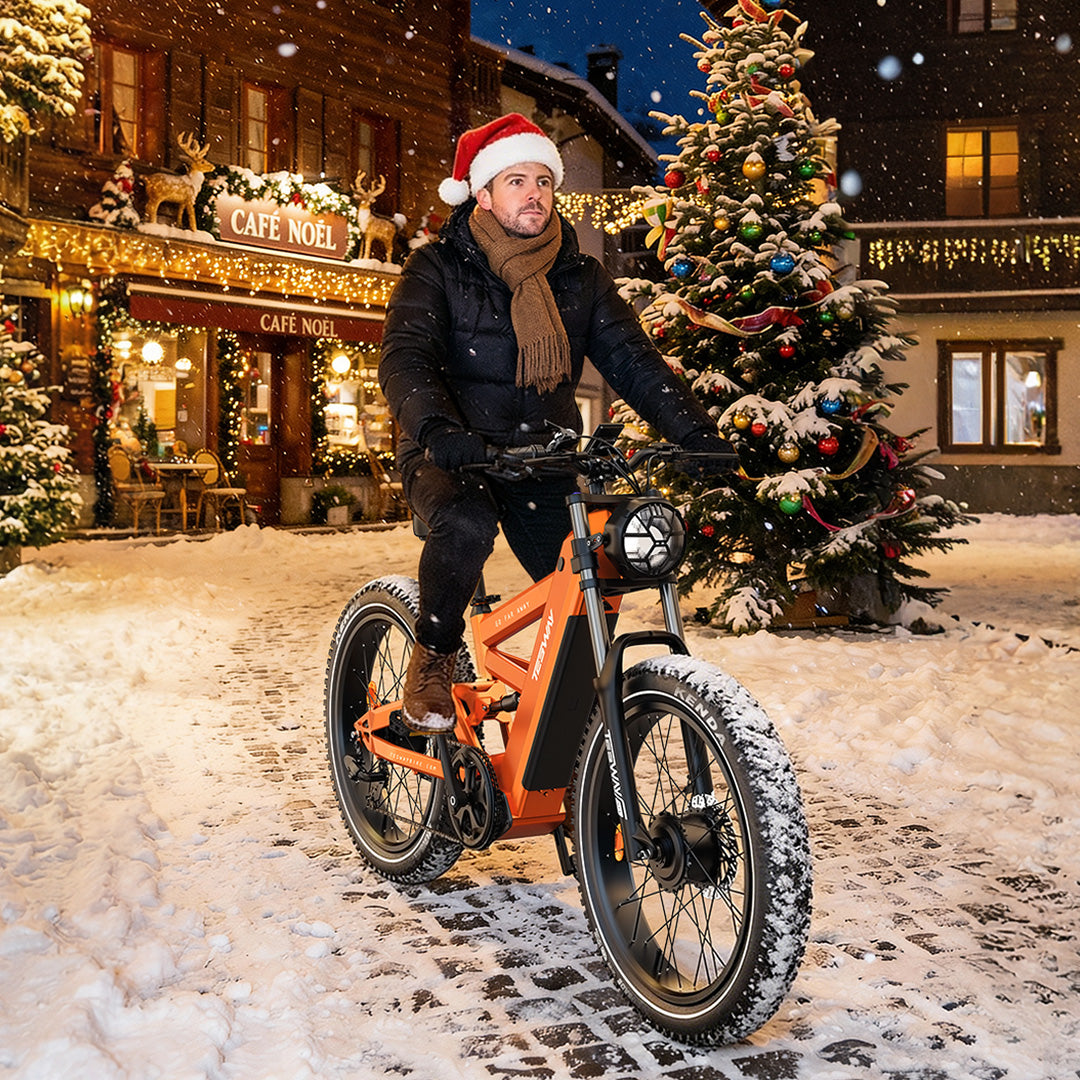There are currently two main types of motors in electric bikes—hub motors and mid-drive motors.
Each motor type brings its own strengths and weaknesses in terms of performance, efficiency, and maintenance.
This article dives into the pros and cons of both, helping you choose the right motor based on your riding style, terrain, and specific needs.
Hub Motors
Hub motors are the original motor style in eBikes. These motors are usually located in the center of the rear wheel (and sometimes in the front). They directly power the wheel rather than the bike's drivetrain.
Advantages of Hub Motors
Simplicity and Cost-Effectiveness
Hub motors are popular because they offer a straightforward, no-frills riding experience. They’re generally more affordable than mid-drive systems, making them ideal for budget-conscious riders or those looking for an entry-level eBike. Their simple design also means fewer moving parts, which can result in lower maintenance costs over time.
Quiet Operation
Since they’re located in the wheel hub and operate independently of the drivetrain, hub motors are often quieter than mid-drive systems. This makes them ideal for those who want a more silent riding experience.
Ease of Installation and Replacement
Hub motors are relatively easy to install and replace. Because they don't involve complex connections to the bike's crank or gears, many riders can install or swap a hub motor without professional help.
Reduced Wear on Drivetrain Components
A hub motor works separately from the bike’s chain and gears, meaning it doesn’t put additional stress on these components. This can extend the lifespan of your chain, cassette, and derailleur, leading to lower long-term maintenance costs.
Disadvantages of Hub Motors
Weight Distribution
Hub motors are heavier and positioned at the wheel’s center, which can throw off the bike’s overall balance. This weight distribution may be noticeable when climbing hills or maneuvering through sharp turns.
Limited Torque for Steeper Terrain
Hub motors tend to lack the torque and power needed for climbing steep hills or rough terrain. If you plan on tackling challenging trails or steep gradients, you may find hub motors lacking in the power department.
Battery Efficiency
Hub motors can be less efficient than mid-drive systems, particularly on varied terrains. They tend to drain the battery faster, which could reduce the range of your eBike, especially if you’re riding on a high-power setting.
SEE ALSO How Electric Bike Works
Mid Drive Motors
Mid-drive motors are newer and mounted at the bike’s crank, where they integrate with the drivetrain. By connecting directly to the bike’s chain or belt, mid-drive motors are designed to work with the bike's gears, maximizing efficiency and performance.
Advantages of Mid-Drive Motors
Superior Torque and Power
Mid-drive motors are generally more powerful and provide better torque than hub motors, making them ideal for climbing steep hills and tackling rugged trails. The added torque makes them a favorite for mountain bikers or riders who often navigate challenging terrain.
Efficient Battery Use
Since mid-drive motors work with the bike’s gears, they use the motor’s power more efficiently. By selecting a lower gear when climbing, for instance, you can conserve battery power, significantly increasing the eBike’s range on a single charge. This efficiency makes mid-drive motors an attractive option for those who prioritize long-distance riding.
Better Weight Distribution
Mid-drive motors are centrally located, which helps balance the bike’s weight. The central weight distribution gives the bike a more natural feel and enhances handling, especially on rough trails or when making sharp turns.
Ease of Maintenance for Wheels and Tires
Since mid-drive motors don’t impact the wheels, maintaining or changing tires is simpler. Unlike hub motors, where the motor is embedded in the wheel, a mid-drive system leaves the wheels independent, making flat repairs or wheel upgrades easier.
Disadvantages of Mid-Drive Motors
Higher Price Point
Mid-drive motors are typically more expensive than hub motors. This price difference reflects the advanced technology, better integration, and increased power they provide, but it can be a deal-breaker for budget-conscious buyers.
Increased Drivetrain Wear
Mid-drive motors add strain to the chain, cassette, and derailleur. Over time, this additional wear can lead to more frequent repairs or replacements of these components, which could result in higher maintenance costs.
Complexity and Installation
Installing or replacing a mid-drive motor is more complex and often requires professional assistance. For DIY enthusiasts, this can be a drawback, especially when compared to the straightforward installation of hub motors.
Performance Comparison
1. Power and Torque
Hub Motors: Suitable for flat or mildly hilly terrain but lack the torque necessary for challenging trails or steep inclines.
Mid Drive Motors: Offer superior torque, making them ideal for steep hills, off-road trails, and heavy loads. They are the go-to choice for mountain bikers or riders who encounter varied terrain.
2. Battery Range and Efficiency
Hub Motors: Generally less efficient and may drain the battery faster, especially on hills or in stop-and-go riding situations.
Mid Drive Motors: More efficient, thanks to their integration with the bike's drivetrain. Riders using mid-drive motors can often achieve a greater range per battery charge.
3. Balance and Handling
Hub Motors: Heavier on the wheel and can affect the bike’s center of gravity. This can be especially noticeable on technical trails or when making sharp turns.
Mid Drive Motors: With their central location, mid-drive motors provide a balanced and more natural ride feel, making them a popular choice for handling sensitive riders.
4. Maintenance and Repairs
Hub Motors: Simpler and generally cheaper to maintain. The motor doesn’t affect the chain or gears, so these components experience less wear and tear.
Mid Drive Motors: Can increase wear on drivetrain parts, meaning chains and gears may need replacing more frequently. Repairs and maintenance are typically more complex and can be costly.
5. Noise Levels
Hub Motors: Generally quieter due to their independent operation from the bike’s gears.
Mid Drive Motors: Some models may produce more noise, especially when riding at high power or on lower gears. This may not appeal to riders looking for a quieter ride.
Which Motor Is Right for You
Deciding between a hub motor and a mid-drive motor ultimately depends on your priorities as a rider:
Hub Motor: You’re looking for an affordable eBike for commuting, casual rides, or flatter terrain. Hub motors are also a good option for DIY enthusiasts who may want to upgrade or repair the motor themselves.
Mid Drive Motor:You’re a serious cyclist tackling steep hills or technical trails, or you need an eBike with maximum battery efficiency for long rides. Mid-drive motors are well-suited for riders looking for enhanced power, balance, and handling.
FAQs
Are mid drive motors more efficient than hub motors?
Yes, mid-drive motors generally use battery power more efficiently due to their integration with the bike’s gears, allowing riders to maximize range and battery life.
Which motor type is better for steep hills?
Mid-drive motors are better suited for steep hills as they offer higher torque and work effectively with the bike’s gear system.
Are hub motors harder to repair than mid drive motors?
Hub motors are typically simpler to repair or replace since they don’t affect the bike’s drivetrain, making them more accessible for DIY repairs.
Recommended Reading
What Are the Benefits of Riding Ebikes?
Could You Pedal Electric Bike
Guide to E-Bike Touring Across the Country
11 Cycling Tips for Beginners
Electric Bike Tires: Should You Choose Thin or Fat?








Share:
Fat Tire vs. Regular Tire eBike: Which One Suits You Best?
7 Health Benefits of Cycling